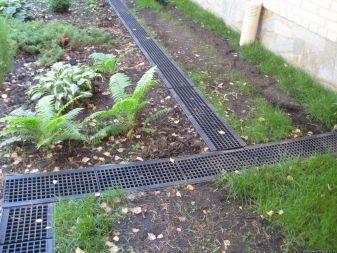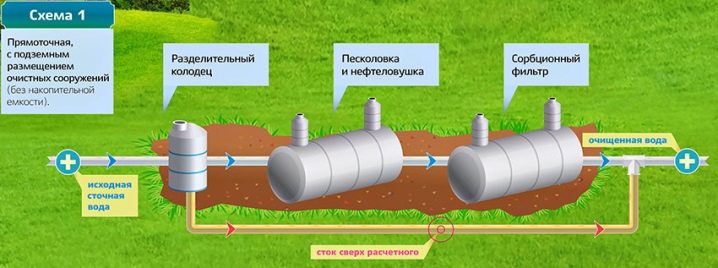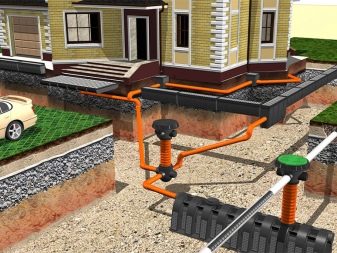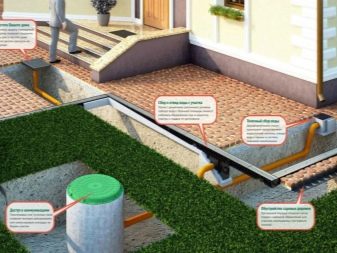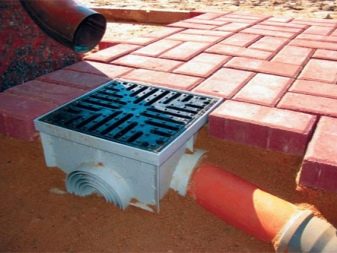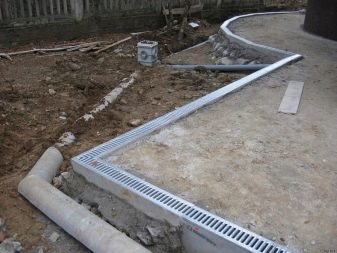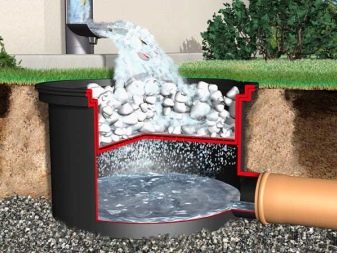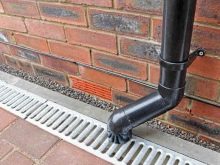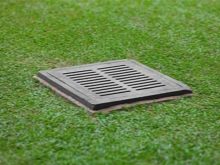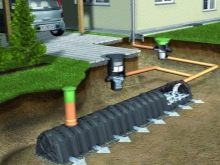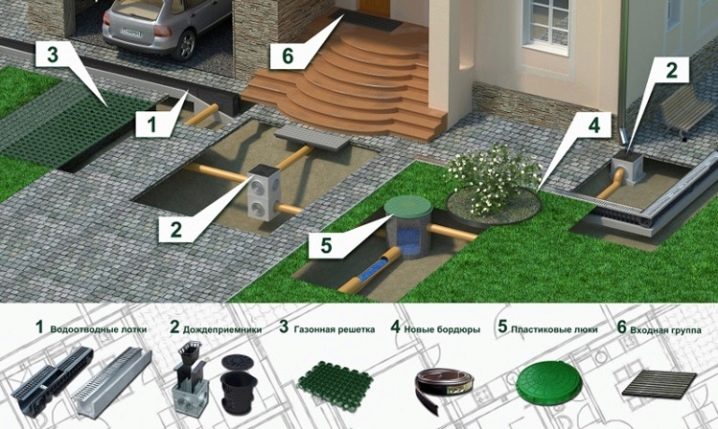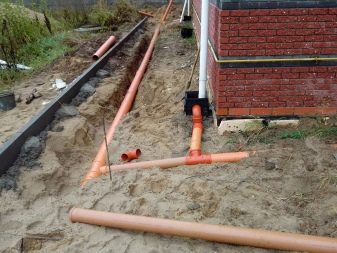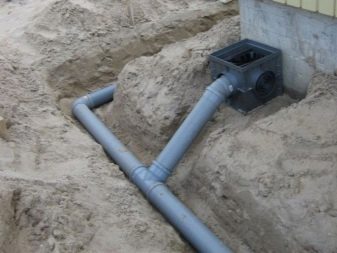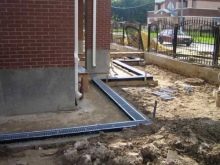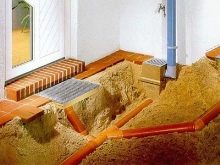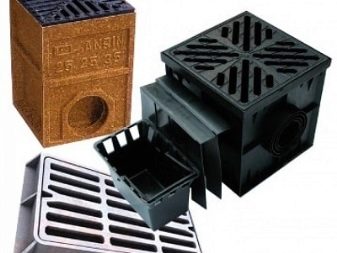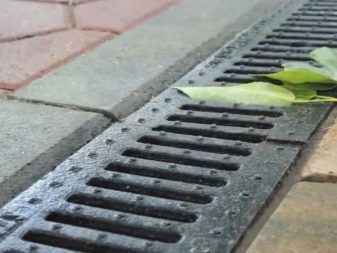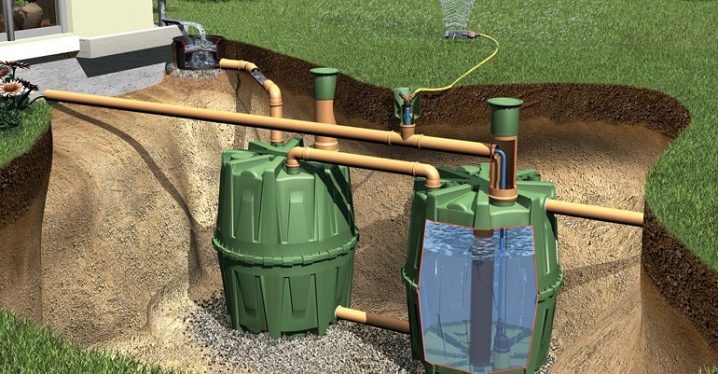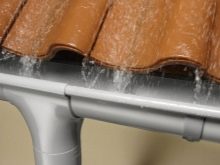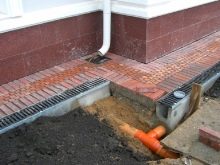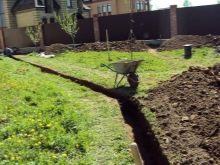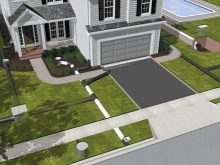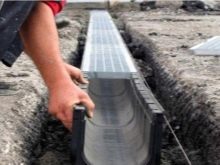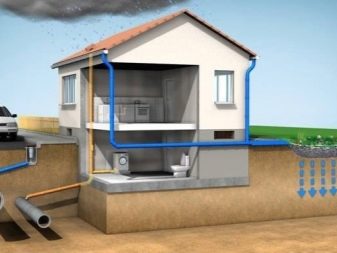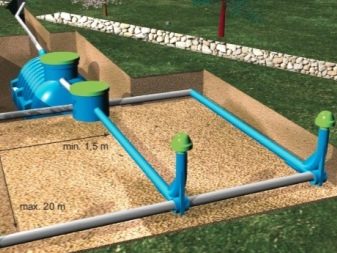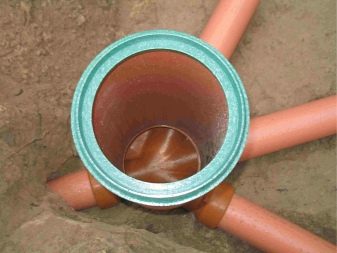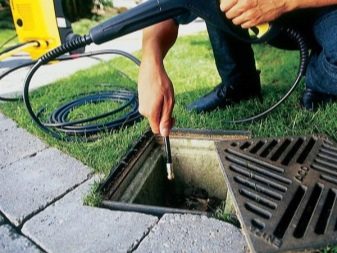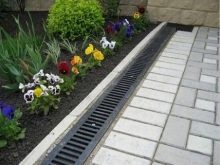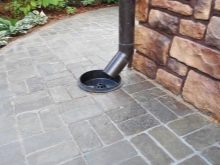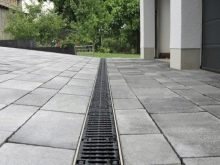Storm sewage: device and features of operation

Any owner of suburban real estate seeks to bring comfort and beauty not only inside your own home, but also on the local area. Realization of such a desire is costly, not only in time but also in money, so it is especially important to foresee any trivialities.
Properly constructed storm sewers will help protect the site from destruction.
Design features
According to statistics, the roof of a dacha or house takes about 100 cubic meters of precipitation over one year. On the soil around the structure of the water gets several times more, which can threaten subsidence of the foundation and the destruction of the house adjoining structures.
Storm sewage is a system by which the main stream of water in the form of precipitation is quickly and to a certain place taken away. Such a drainage system must necessarily be organized in a private house, large storage and shopping complexes, at various factories and in places of congestion of cars. Places where products of petrochemistry and various hazardous industries can get into rain and thawed wastewater should also have good drainage.
The principle of operation of the stormwater system is the "collection" of water on the surface of the earth, its purification and transportation to a special tank for further use. This system includes:
- distribution well;
- sand separators;
- grease separators;
- filter adsorber;
- control well.
Water is collected into the well through special open or closed gutters. The cleaning itself starts from the distribution tank, from which the liquid enters the sand separators. Large particles of sand and small debris are filtered into them, and then grease separators, which are also called oil and fuel catchers, come into play.
The next in line is usually the adsorber filter, which cleans the water from petrochemical products and sends it to the control well. Purified wastewater can be used for watering or filling various reservoirs.In some cases, it is possible to install an additional UV collector and a storage tank, however this is not mandatory.
All components of the storm sewer system are combined in one line, and most of them, including the conductive pipes, are buried beneath the ground. Such an arrangement of large components of the drainage system does not deform the road and saves a maximum of space on the site. If the deepening of the supply open gutters made of concrete, asbestos or plastic is not possible, they are placed in special gutters with a bias towards the distribution well.
The drainage system is designed according to SNiP 2.04.03-85 individually for each site. Design documentation is developed on the basis of SanPiN 2.1.5.980-00 and GOST 3634-99. The best option would be to entrust the development of such a complex system to specialists.
In this case, you can get a guarantee of reliability and durability, the tanks will be precisely designed for the right amount of precipitation, and the pipes will be dug into the depth that will allow the water not to freeze in the autumn-winter period and not to deform the system.
A simple point stormwater drainage system is several inlets, installed under the gutters and connected in one system. The main element of such a system are the sand catchers of various designs. The purpose of such a system is to collect excess water falling from the roof and transport it to the tank. The linear type of sewage system is more complex in design and purpose - precipitation is collected not only from the building, but also from the soil on the site of the estate. In this case, a network of drain pipes or chutes and the main collector are mounted with an additional inlets.
Kinds
Depending on the type of system, storm sewers can be:
- dotted;
- linear.
You can install special pallets near the entrance to the building and the fence gate, which will prevent soil leaching and preserve the integrity of the structures for a long time.
Professionals recommend additional installation of audit wells in large areas - with their help, you can carry out preventive cleaning of the sewage system and check the correct operation of the entire system.
Also, storm sewer varies by type of location to the soil surface. In this case, it happens:
- outdoor;
- internal;
- mixed.
The simplest method of drainage is an outdoor storm system. The result is achieved at minimum cost and maximum design simplicity. Open drainage includes only two elements - these are linear drainage systems in the form of ground gutters and sand traps recessed into the ground. Gutters are located under the gutters and along the paths in the blind area. Such a system often drains the collected moisture on a lawn or flower bed, and in cases where there is a small body of water on the site, the water is sent there.
Internal storm sewage, according to professional builders, is more preferable, as it guarantees the absence of puddles on paths and lawns. However, such a system, closed under a layer of soil, is costly and involves specialists for calculations and works. Compared with an open shower, a closed type of sewage has a large number of elements.
Linear gutters, installed under the slope, and the inlets are closed by additional gratings. Such grids do not allow clogging of underground pipes with large debris and leaves, and can also carry a decorative function.Door pallets protect the gate and the porch, and lawn grills protect plants located in the lowlands of the site.
Hidden under the ground, a pipe system with a minimum number of bends at an incline gives water to the reservoir. Throughout the system, additional manholes can be installed, which serve to clean and repair the sewage system. The fluid accumulated in the collector can be used for irrigation or discharged into certain tanks created by artificial means.
A mixed system is a compromise between open and closed type. In this case, the closed elements provide drainage from drains from the roof, and open troughs are installed along fences, platforms and roads. Such a combination can significantly save money and not lose in quality.
In addition to conventional systems that transport water in a natural way due to the slope of the pipes, there are other options.that help the flow of water due to its design features. For example, the gravitational-vacuum drainage system allows to “suck” water from the roof due to the difference in the height of the funnel and the drain.Such a system is also called a siphon, since it is built on the same principle as a siphon in an ordinary sink. Another example is the pressure storm sewer, the movement of water in which is carried out by pumps installed in certain areas. Additionally, these pumps are equipped with garbage shredders, which prevents the formation of blockages inside the underground pipes.
Equipment
In order to correctly choose the structural elements of the network and sewage facilities from the whole variety represented on the construction market, it is necessary to decide on their design and material.
- Gutters and stormwater inlets. Waterways can be made of concrete and plastic. You should not choose metal options, as they are not only susceptible to corrosion when interacting with moisture, but also make a lot of noise when it rains and gusts of wind when installed above the ground. Concrete structures are more reliable and have a longer life, but their diameters are strictly regulated, so it is not always possible to install them on the site. Plastic gutters are easily cut and aligned, and plastic inlets can have any depth of the well.If the blind area is already installed, then such gutters are easy to install along its perimeter without dismantling.
- Lattice. This protective element allows you to less often clean the system, besides the grate covering the chute from above, eliminates the risk of stumble. Cast iron grates are long and very reliable, but require repainting every 2-3 years. Steel protection of inlets wells is not very practical, as it rusts very quickly. The ideal option is aluminum. Such structures have a long service life and look great on the entire lifetime, but they are much more expensive. The size of the holes of any lattice should not be too small, as it will have to pass a lot of liquid at once. But too large cells are also unacceptable - they will miss the garbage, which can lead to blockages.
- Pipes. PVC pipes are the best solution for the installation of stormwater at a country site. Unlike asbestos and cast iron pipes, their corrosion is minimal, and the smooth inner surface virtually eliminates the risk of overgrowth with sludge. The smallest diameter of such pipes is 110 mm, and with a large roof area and a large number of tracks, their diameter can reach 150 mm.
- Collector. This element is present in closed and mixed storm sewer systems.It is a large container in which the bulk of the water accumulates. Such a well can be constructed from rings and a pillow made of concrete, or from a ring with a bottom (in the event that further use of the collected moisture is planned). If precipitation is planned to simply be diverted from the site, then the best option would be to install a well without a bottom in sandy soil. The main thing is not to get into the aquifer, otherwise the collector will turn into a normal well.
Plastic collector is assembled using PVC forms. It is perfect for sites on which the surface occurrence of groundwater. The accumulated fluid is discharged through the pipeline system or used for household needs on the site itself.
In addition to the usual collector, you can equip the drainage system, discharging water into the soil. A special plastic container is located horizontally in a layer of soil that absorbs water well, for example, in sand. It makes no sense to organize such a system in clay soil, since it practically does not absorb moisture. The walls of the tank have many small holes through which water gradually seeps into the soil, preventing it from oversaturation.
In addition to the above method of drainage, the collector can be attached to the riser of the central sewer system and remove the water in specially designated reservoirs and sewage treatment plants. If a simple submersible pump connected to an irrigation system is installed inside such a well, then you can save a lot on water bills.
Installation steps
Installation of storm water for the yard on its own site - the process is quite time-consuming. The best solution is to hire professionals, but if you want to save money, you can do all the work yourself.
Such work does not require special skills, and it is carried out according to the algorithm described below.
- A scheme is drawn up on a scale of the entire plot with buildings. Well, if it will be done using a graphical editor, but you can use regular paper with a pencil.
- The lowest point in the area where the collector will be installed is determined. If the plot seems fairly flat, then you can simply choose a convenient place.
- All catchment points are marked: roof drains, concrete pads, gates and walkways.After that, the drawing shows the system of the resulting pipeline with all the elements and connections. It is not necessary to lay in it a lot of turns of pipes - this makes it difficult for the water to flow through them. If you can not avoid them, then the best option would be to rotate 90 degrees.
- After the drawing is ready, and all inaccuracies are corrected, it is possible to calculate the amount of necessary materials. If the hardware store or the market is within walking distance from the site, then it is better not to buy more material than to purchase a surplus, since there is no need to select materials by color and pattern.
- First of all, the installation of the roof part of the shower is carried out. In the overlap holes, storm water inlets are planted on the bitumen mastic, mounted on the gutter suspension and risers, and a water discharge unit is arranged in the collector or tray.
- The plot is marked with stretched ropes, and all the necessary trenches and hollows are pulled out. So that the water in the pipes does not freeze even in winter, you need to dig to the depth of soil freezing or insulate the whole system - otherwise, the sewage system will not function from late autumn until early spring.At the bottom of the trenches, sand is poured and packed tightly. It will avoid soil subsidence, which can lead to a change in the inclination of the pipe and the formation of congestion. On the sand, crushed stone is covered with a layer thickness of 5-8 cm, which, on the contrary, protects the pipes from soil swelling.
- First, the collector is mounted and concreted, as well as wells and storm water inlets. If PVC elements are used, they need to be pressed down with a load until the solution hardens completely, otherwise they will "emerge" from it. After that, the pipe system itself is mounted. Before digging in the excavated areas, the sewage is checked for leaks and serviceability, after which it is possible to fill all with earth.
Secured territory
In order for the installed storm sewage system to meet all standards and requirements, it is necessary to equip special security zones. They are forbidden to make garbage dumps, to build both permanent country houses and any temporary buildings. In security zones do not equip parking and do not plant plants closer than 3 meters from the pipe. At the site or cottage to make a security zone is much easier, since the requirements for them are softer.But parking above the pipe system of such sewage is still not recommended, otherwise the risk of collapse of the whole structure increases.
Service
A flooding plant, like any drainage system, should be subject to regular maintenance:
- periodic inspection and cleaning of all collectors and wells (all blockages need to be punched, rubbish removed);
- general flushing of the entire system every few years (3-4 years).
In addition to cleaning garbage and blockages, it is necessary to control the level of sludge at the bottom of wells, which can get into the underground systems and cause blockages. The well is cleaned of sludge using a fecal automatic pump.
System cleaning consists of:
- preparation (pumping out all the water from the system using a pump fixed 0.5 m above the level of the bottom of the well);
- cleaning itself (flushing the system with clean water using the same pump).
In case of severe contamination of the shower, the procedure can be repeated several times.
In order to carry out major cleaning of the entire system, it is necessary to have a special pneumatic installation with various nozzles for cleaning underground pipes. Most often, experts are invited to do this.
Open-type open-air floes in winter are simply covered with a layer of ice and snow, which can be thawed manually or you can wait for natural thawing with the arrival of spring. But in a closed system of storm sewers, not buried to a depth greater than the depth of soil freezing, manually melt the ice does not work. Therefore, such a system can be "preserved" before the onset of heat. It is necessary to clean it, drain excess water, leaving no more than three quarters of water, and close all inlets of such a system.
Properly organized storm sewage on the site, behind which the necessary care is carried out, will not only remove excess water to protect buildings and plantings, but will also become an additional decorative element for the yard and the house. The roof, equipped with hanging gutters and a riser, looks complete, and the sound of water flowing through such pipes in the rain will serve as an excellent accompaniment for a restful sleep.
In the next video you will find the installation of storm sewer.

